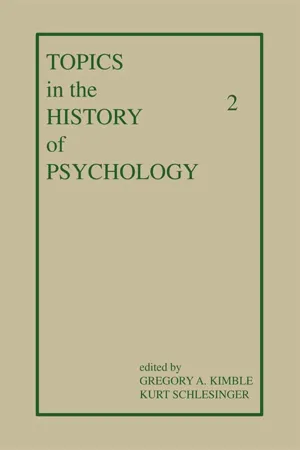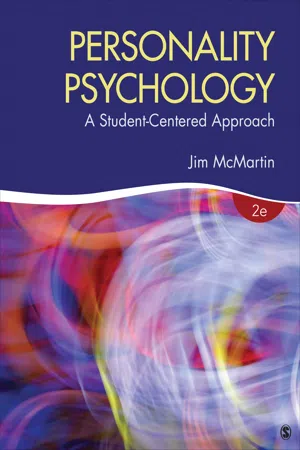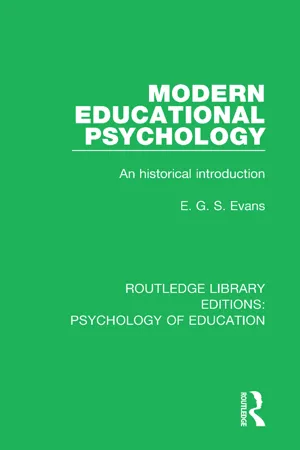Psychology
Theories of Personality
Theories of personality in psychology are frameworks that seek to explain and understand individual differences in behavior, thoughts, and emotions. These theories attempt to identify and describe the underlying factors that shape an individual's personality, such as genetics, environment, and personal experiences. They provide valuable insights into human behavior and contribute to our understanding of individual differences.
Written by Perlego with AI-assistance
Related key terms
8 Key excerpts on "Theories of Personality"
- eBook - ePub
Topics in the History of Psychology
Volume II
- G. A. Kimble, K. Schlesinger(Authors)
- 2014(Publication Date)
- Psychology Press(Publisher)
10 Approaches to Personality Theory Ruth G. MatarazzoAnn M. GarnerUniversity of Oregon Health Sciences CenterFew branches of psychology are more complex, controversial, and wide-ranging than those dealing with human personality. Our attempts, over the centuries, to comprehend others, to satisfy our need to interact with them, and to predict what they will do has led to an unending variety of descriptions and explanations of personality. These efforts at understanding may or may not deserve the title of “theory,” depending upon how stringently one applies the term. They do illustrate, however, the wide range of assumptions, methods, and conclusions that continues to characterize the broad field of personality study.There are at least three factors which contribute to this diversity. For one thing, there is no single, generally accepted definition of “personality.” Personality may be seen as a property of a person or as a field of study; it may take on connotations of value, so that one is said to have a “good” or “bad” personality; it may refer to biological or to social aspects of behavior; it may be considered the product of the environment or its determinant; flexible or unchanging; the central core of the person or a collection of characteristics. Seldom do two theorists in the field begin with, or generate, the same basic definition of the phenomenon.Secondly, the source of data from which personality theories are fashioned varies widely. Some of the earliest and most elaborate theories derive from clinical observation of persons who show some form of pathology. Others stem from responses of large populations of subjects to items on scales of personality assessment. Some are based on behavior in narrowly defined laboratory situations as, for example, the animal studies of Miller and his associates at Yale. Others employ field or naturalistic situations as their testing ground, as we shall see in the discussion of Maslow and other phenomenological theorists. - eBook - ePub
Sport, Exercise, and Performance Psychology
Theories and Applications
- Angus Mugford, J. Gualberto Cremades(Authors)
- 2018(Publication Date)
- Routledge(Publisher)
Relatedly and, given their specific performance roles, the individual performer experiences particular personality states and manifests certain personal actions. These experiences form a distinct pattern of functioning, that will vary, somewhat, given time, situation, and circumstance.THEORIES
Personality has been the subject of theory development and research for many decades, across a range of disciplines (Reville, 1995). This has occurred most notably in personality psychology and social psychology and also to a lesser degree in sport psychology (Allen et al., 2013).Within this context, Theories of Personality have relevance for professional practice in sport, exercise and performance psychology for several reasons. These reasons include:- An individual performer’s personality structure – that is the way that their personality is described and understood – can offer the practitioner with practical knowledge of the performer as a person, over and above the individual’s particular performance domain (e.g., sport, exercise, other areas of performance). A description of the personality of the performer, therefore, gives the sport and performance psychology practitioner a picture of who the individual performer is as a person (Rhodes & Pfaeffli, 2012). This information can be used in becoming more acquainted with the performer and in using that information with respect to designing appropriate interventions as well as guiding the individual as part of sport and performance counseling.
- An individual performer’s overall personality profile also can help the practitioner to identify how likely it is for the individual to react to people, places and things that could put the particular performer at risk (Maher, 2011; Nideffer & Sagal, 2001). This may involve risk for becoming influenced by negative people or situations including the use and abuse of substances. In this regard, personality-related information can help the practitioner to consider whether and to what extent the individual performer can cope with personal risk (Nia & Beshort, 2010).
- eBook - ePub
Personality, Design and Marketing
Matching Design to Customer Personal Preferences
- Gloria Moss(Author)
- 2017(Publication Date)
- Routledge(Publisher)
Explanations of human personality have a long tradition of theorising that stands outside the mainstream of trait approaches. Furthermore, modern perspectives, such as positive psychology, recent conceptual leaps in cognitive psychology and the emergence of modern psychodynamic viewpoints, are offering alternative ways of conceptualising and measuring people’s characteristics and each has a different focus. In fact, having a variety of theoretical perspectives is valuable for understanding something as vital to humanity as personality. Not surprisingly, we still await the discovery of that single grand theory that can tell us everything we need to know about how a person’s feelings, thoughts, actions, interactions, motives and preferences make up his or her complete personality. Therefore, while each approach has its merits and limitations, it is quite reasonable to ‘sit on the fence’ and not feel any obligation to choose one perspective as being the right one. Indeed, in this chapter, the point being made is that it is advisable to consider that there may be both conscious and unconscious routes to personality development; that examining one’s motivation for growth and development need not contradict those views that focus on people’s conflicts within the psyche; and that measuring one’s traits as behavioural patterns does not negate the importance of exploring and understanding both the cognitive processes and neurological activities underlying those patterns. Moreover, just because many theorists and researchers of differential psychology concentrate on knowing more about those important human traits that appear to be universal, this does not undermine the significance of examining how the broader culture and experience can account for wide inter-individual differences. Major life experiences and deliberate self-development can promote intra-individual changes in people’s personality traits at different phases across their lives. Thus, each of the different perspectives has something useful and important to offer in aspiring towards a complete picture of the multifaceted psychological constituents that make people different from each other and that define who they are as unique individuals.The first section in this chapter compares the viewpoint that traits are an inclusive set of dispositions shared by all people against a different viewpoint that an individual’s underlying traits are exclusive to only that particular person. The mainstream trait approach largely adopts the former perspective, and this is compared to the view of personality as being essentially idiosyncratic rather than comparable across every one of us. In the second section, the comparison is made between psychodynamic perspectives (that tend to focus on unresolved early life experiences and the unconscious mind) and cognitive theories (that examine the largely consciously accessible thinking habits that make people who they are). The third section addresses the issue of the role of biology versus experience on personality, examining evidence of inherited temperamental differences between individuals and discussing how experience and nature interact in the development of personality across the lifespan. The fourth section of the chapter discusses a set of theories and research about personality that can be subsumed under the umbrella of positive psychology. Historically, personality theorists have often also been clinicians with an interest in personality pathology. Positive psychology strays from this tradition by considering the overarching driving force of human nature as leaning towards healthy personality development and flourishing. - eBook - ePub
Personality Psychology
A Student-Centered Approach
- James (Jim) A. McMartin(Author)
- 2016(Publication Date)
- SAGE Publications, Inc(Publisher)
1 Using Theory and Research to Understand Personality: What are Theories of Personality, and why are they important?- Basic Questions About Theories
- What Is a Theory?
- What Are the Functions of a Theory?
- How Can I Tell a Good Theory From a Poor Theory?
- Five Personality Theories
- The Psychodynamic Orientation
- Trait Theory
- Cognitive/Social Learning Theory
- Humanistic/Existential/Narrative Theory
- Evolutionary Personality Theory
A theory is like a map. Theories are devices to help us get from here (our present knowledge) to there (a better understanding of nature). Thus, the primary question one asks about any map or any theory is, Is it useful? Does it represent reality accurately enough so we can make sense of where we are now? Does it help us get to where we want to go?Why is it important to know theory? The simplest and most direct answer is that every person is a complex system of feelings, thoughts, goals, plans, and so on. Every person has a unique history, functions (more or less) in the present moment, and has (or despairs of having) meaningful hopes for the future. If we want to understand how any complex system works, we need a good theory, just as we need a good map to help us find our way around a complex city. We need good Theories of Personality to help us answer interesting and important questions about ourselves and other people.We use personality theory throughout the book to help answer questions concerning our similarities and differences. To appreciate how a theory helps answer questions, we first need a basic understanding of the nature of scientific theories. In the first part of this chapter, we outline what a theory is, what functions it serves, and how to tell a good one from a bad one. All theories, like all maps, are not created equal.Basic Questions About Theories
What Is a Theory?
A theory is a conceptual scheme that attempts to organize and explain the facts of nature in terms of general principles or laws - eBook - ePub
Child and Adolescent Psychology
Typical and Atypical Development
- Stephen von Tetzchner(Author)
- 2018(Publication Date)
- Routledge(Publisher)
2 THEORETICAL PERSPECTIVESThis chapter provides a brief introduction to the foundations of theory formation and the most important theoretical perspectives in developmental psychology: psychodynamic psychology, behaviorism, logical constructivism, social constructivism, evolutionary psychology, ethological psychology, ecological psychology, information processing and critical psychology. They differ in their emphasis and explanations of developmental phenomena and together they illustrate the breadth of developmental thinking in the twenty-first century. Each of them comprises many assumptions and hypotheses, and constitutes a basis for many smaller theories.The theories are presented in more detail in parts of the book where they are relevant, including critical comments. Chapter 10 , for example, discusses the cognitive aspects of the theories, while Chapter 18 discusses the development of personality.THE FUNCTION OF DEVELOPMENTAL THEORIES
Developmental theories are intellectual tools for categorizing and making sense of observations of children’s actions and reactions and their environment, and explaining typical and atypical developmental trajectories. As all tools, they must be functional and solid. A good theory requires a coherent set of interconnected concepts and a terminology that can be used to describe the development of the psychological phenomena and explain the relevant processes, for example concepts that can characterize children’s changing thinking or emotion understanding, and the processes that underlie these developmental changes (see Chapters 10 and 17 ). “The usefulness of theories may be evaluated in regard to its attributes of precision, scope and deployability” (Lerner, 2002, p. 11).According to Popper (1959), a theory has to be testable in order to be scientific. The first test of whether a theory is sound and tenable is to establish if it can account for and integrate existing research findings (Lerner, 2002). Popper also points out that theories cannot be proven - eBook - ePub
Modern Educational Psychology
An Historical Introduction
- E.G.S. Evans(Author)
- 2017(Publication Date)
- Routledge(Publisher)
2 Theories of Personality formationIntroductionAnother notable feature of modern educational psychology is the emphasis that is given, not only to the experimental investigation of the different stages of children’s development but to more general considerations of how their personalities are formed. This latter approach is represented by contemporary psychological Theories of Personality, as well as those of the recent past, and the purpose of this chapter is to outline the more important of these, and to discuss their implications both for the teacher and the child. From a developmental point of view, the basic questions here are, ‘How does the self constitute itself in its growth?’ ‘How are the social and emotional qualities of children’s personalities formed and what bearing do these have on their schooling and everyday life?’It will be appreciated that it is beyond the scope of a review such as this to give detailed descriptions of all the notions and experiments about the formation of the human personality, and that they must, of necessity, be treated somewhat summarily in order to allow for a reasonable With this qualification, the following theories will be considered: depth or psychoanalytic theory: social-field accounts; early theories of instinct and recent advances in this field; the theory of learned drives and functional autonomy developed by G. W. Allport; factorial or structural studies, both British and American, of various personality topics in the fields of general psychology and child development.Depth or psychoanalytic theoryThe principal doctrines of the depth or psychoanalytic school of psychology are those of Freud (1915, 1923, 1927, etc.), Jung (1921, 1923, 1953, 1954) and Adler (1935, 1958), and their modern derivatives, namely, the psychology of ego-involvement and personal identity (Anna Freud, 1937, Erikson, 1950) and the psychoanalytic theory of object-relations (Klein, 1948, Fairbairn, 1952). Although there are important differences between these accounts, they have certain features in common. In the first place, they all stress the continuity of the psychic processes underlying both normal and abnormal behaviour. Second, they assume the existence in each person of an unconscious mind, believing that much of an individual’s behaviour is influenced by motives he is not aware of. As Knight (1958) has pointed out, for Freud these unconscious motives consisted mainly of repressed sentiments, for Adler they were unverbalized attitudes and for Jung, unrealized potentialities. In all cases, however, they were mediated through such processes as repression, identification, sublimation, transference and so on. - eBook - ePub
Companion Encyclopedia of Psychology
Volume One
- Andrew M. Colman(Author)
- 2018(Publication Date)
- Routledge(Publisher)
The final important origin of the view that personality is a construction is to be found in the more generic theory of the social construction of reality developed by the sociologists Berger and Luckmann (1967). Like sociology, and in contrast to the physical sciences, much of psychology is concerned with the study of abstract concepts that have no direct counterparts in the physical world (Gergen, 1985). For example, stages in the life cycle such as "old age" have acquired a social reality because our culture enriches them with specific meanings. Thus, at an arbitrary retirement age, a person joins the ranks of "the elderly" and is subjected to a pervasive separatism that reflects our negative constructions of ageing (Estes, 1979). A person's identity or personality may also be viewed as having a social reality constructed by cultural beliefs and practices (Gergen & Davis, 1985).In sum, the construction of personality, as a metatheory for personality psychology, draws on the dramaturgical approach and the social constructionist theory of social reality. The constructivist approach to personality was developed to achieve two related purposes: (1) to integrate the study of personality and the study of person perception, and (2) to provide a broad theoretical framework within which the various perspectives on personality can be placed (Hampson, 1988). The framework will now be presented in more detail.The Actor in Personality Construction
The emphasis on the actor in past personality psychology is the result of the view that personality in some sense "resides" within the individual. This view has been pursued through biological, psychodynamic, and trait theories. This position is most easily appreciated in a biological approach to personality, such as Eysenck's (see Eysenck, 1967, 1991). The idea that personality has a biological substrate is as old as the ancient Greek theory of the four humours. According to Eysenck, personality may be reduced to three biologically based dimensions of individual variation: extraversion, neuroticism, and psychoticism. - eBook - ePub
- Jule Specht, Jule Specht(Authors)
- 2017(Publication Date)
- Academic Press(Publisher)
Part Three Theoretical Perspectives on Personality Development Outline7 Five-Factor Theory and personality development 8 Theoretical perspectives on the interplay of nature and nurture in personality development 9 Set-Point Theory and personality development: Reconciliation of a paradox 10 Evolutionary aspects of personality development: Evidence from nonhuman animals 11 A critical evaluation of the Neo-Socioanalytic Model of personalityPassage contains an image
7Five-Factor Theory and personality development
René Mõttus, University of Edinburgh, Edinburgh, United KingdomAbstract
Five-Factor Theory (FFT) distinguishes between two layers of stable personality characteristics. Basic tendencies are defined as underlying dispositions that are isolated from any external influences and thereby develop according to an intrinsic, genetically driven program. This claim is supported by findings that the covariation structures of personality characteristics are similar in different cultural backgrounds, as are age differences in the scores of tests that attempt to tap basic tendencies. Furthermore, there is a lack of robust evidence regarding specific environmental factors that could contribute to changes in basic tendencies. However, basic tendencies are hypothesized to interact with environment to produce another layer of personality, mental structures called characteristic adaptations. Therefore, external influences can influence personality development according to FFT, but this happens at the level of characteristic adaptations rather than at the level of basic tendencies. Further research is required to empirically distinguish between developments at the two layers of personality.Keywords
Five-Factor Model; Five-Factor Theory; development; characteristic adaptations; basic tendenciesFive-Factor Theory and personality development
Five-Factor Theory (FFT; McCrae & Costa, 2008 ) is one of the grand theories of current personality psychology. Its foundations are built on empirical evidence and the interpretation of this evidence is guided by some time-tested hypotheses from earlier theorists such as Allport, Cattell, and Eysenck. It is a comprehensive theory in that it covers most of what personality researchers are typically looking into such as traits, behavior, social-cognitive constructs, and their connections. And FFT is an evolving theory in that it attempts to keep up with new evidence and expand to new territories (McCrae, 2015 , 2016
Learn about this page
Index pages curate the most relevant extracts from our library of academic textbooks. They’ve been created using an in-house natural language model (NLM), each adding context and meaning to key research topics.







